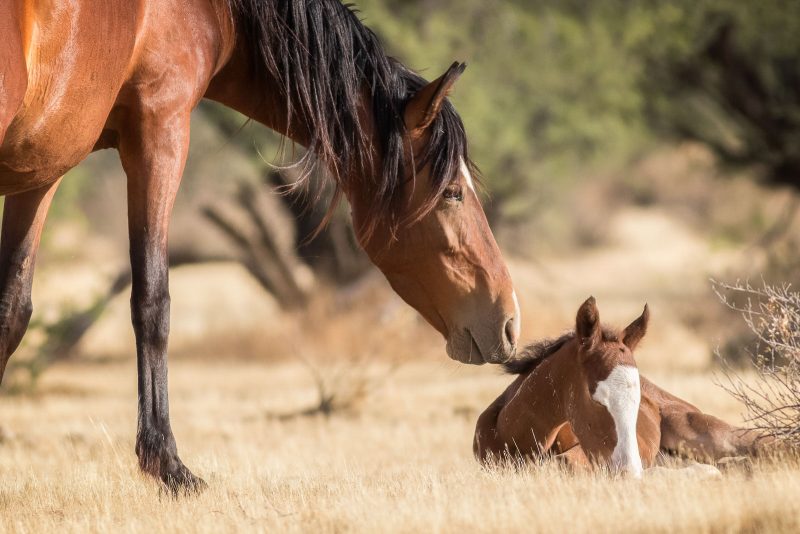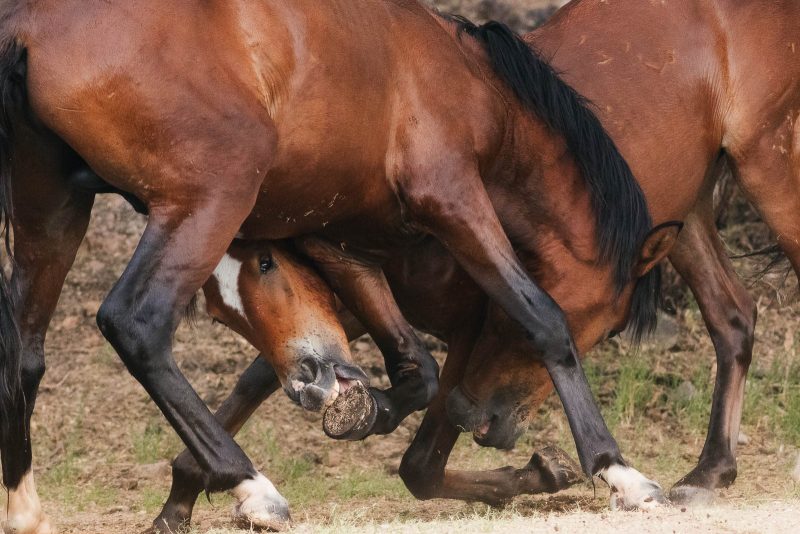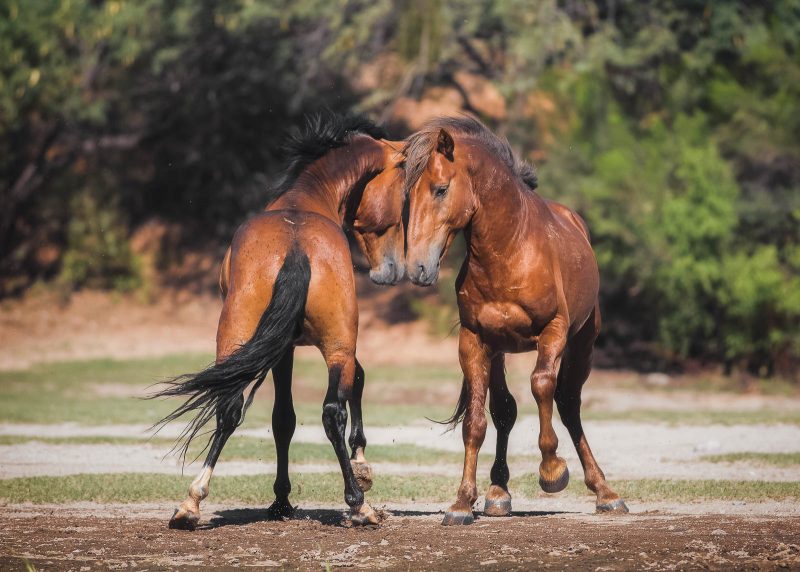How to Photograph Wild Horses in the USA

Imagine photographing a night landscape at 2am when 40 horses run past you in the dark. Without knowing anything about them, what would go through your mind? Well, this very thing happened to me on a full moon night in May 2015. It was completely surreal and I had no idea how greatly this would change my life. After being mesmerised for about an hour, there was a birth of a baby mustang 50 feet in front of me.
I decided to name him Luna, and this event would change my life for the better. Since that magical night I have been a wild horse photographer and have spent the last 5 years chasing that feeling of serenity that I get when in their presence, and watching Luna grow into a strong stallion.


Photographing the wild horses may come with some baggage, unfortunately. Their mere existence causes a lot of heated political debates and not everyone wants them around (and they are loud about it). Unless activism runs through your blood, just be a positive advocate through your pictures. Tell their story, and show their beauty.
Mustangs, or any other free-roaming horse, are descendants from domesticated horses – some ancient descendants! There is only one true wild (never domesticated) horse breed in the world, and it’s the Przewalski horse in Mongolia.
Humans started domesticating the wild horses over 5,500 years ago. Our civilization was built on the backs of horses. The domesticated bloodlines of current free-roaming horses should have no effect on how they are perceived or protected. For all intents and purposes, they are wild horses.
Planning your shoot
Some wild horse experiences happen just by being in the right place at the right time. However, planning, patience, and understanding behaviours can land you some amazing photographic opportunities.
First, let’s talk about how to plan your day photographing wild horses. Typically these trips won’t include just taking photos, as it often requires early mornings and taking your vehicle off-road, as well as long hikes with elevation changes.
Prepare yourself with plenty of water, hiking supplies, and durable shoes.
Many herds in the United States are federally, or state, protected. Do some research to see if the herd you are visiting is managed by a local government group, or federally by the Bureau of Land Management (BLM). If so, contact them to find out some more information, as they will typically help you to have a more successful visit.
For example, the Salt River Wild Horse Management Group is a great contact for the Salt River horses here in Arizona. There may also be social media groups that are specific to that herd. However, help could be mixed as some of the groups are very protective over the herds and specifics can be hard to come by. Other photographers who frequent the area can also be a great resource, and may offer workshops in that area.
Take any information you gathered and survey the area in Google Maps/Earth for parking, trails, and watering holes in the area. Don’t plan to just park and start shooting. Herds will most likely be far away from any paved roads or civilization, and they can travel a tremendous distance in a day.
It’s never a guarantee you will find them, but you will be rewarded when you do! As you prepare to head out, always remember – leave no trace, come prepared, and be respectful of all wildlife.
Photographing wild horses in the USA
When photographing the wild horses, or any wildlife, the goal is to capture natural behaviours in their natural environment without your presence having an effect on their behaviour.
Field craft
Horses in a wild environment behave differently than domesticated horses. They are very territorial, family oriented, and skittish towards humans. Some herds are more familiar with people than others, but you can expect to be studied as you approach.
This is done with a strong look directly at you, with their ears pointed in your direction. This is a crucial moment in gaining trust. Just stop approaching, and don’t stare directly back. It’s the perfect moment to snap a couple photos and they will shortly know you are not a threat.
They all have certain distances where trust will be broken. You should never be closer than 50 feet. Some are more curious than others and will approach you even closer than 50 feet. For safety, I can only recommend that you back away if they do. They are wild, and unpredictable. At most, they just want to smell you.
Group systems
The herds are broken down into “bands,” and you will rarely see a lone wild horse. Larger bands are run by the strongest stallions and typically have several mares, foals, and sentry stallions. Smaller bands are typically younger stallions, freshly off the bachelor band.
When a colt (young male) reaches an age around 2, they will start to be pressured by the stallion to go out on their own. I believe this is largely inherent to stop any inbreeding.
Once they are kicked out, the solo males will band up as a band of bachelors. These males will spar with each other until they are strong enough to fight a lead stallion to steal a mare. The bachelor bands are a very fun, energetic group to photograph.
Predicting movements
All herds will have specific behaviours unique to their environment. However, they will all seek water, food, and safety. It goes without saying, right? So find where they get water from, and where grazing is abundant at that time of year. You will soon be able to anticipate the behaviors and set up specific shots.
They will typically drink in the morning and before sunset, and graze the rest of the day. They eat and stand around a lot, too! When you see a group standing around, they are generally resting in a state called “stay apparatus”. Activity is pretty low during these times, so the best times for photos is the early mornings, or late afternoon.
Read more: Photographing a Species In-depth
Unique behaviours
One very specific behaviour unique to the Salt River wild horses here in Arizona is that they are very adapted to being comfortable in the water, and they “snorkel” for eelgrass. You will hardly ever see a horse submerge their entire head in water for food, but it is very common with them.
Look for unique behaviours like this to photograph, as they are fantastic opportunities for unique images.
Foals and breeding season
Foaling season is generally from spring through to the end of summer. It’s a great time to photograph the horses, but even more space is needed for very young foals.
At about 2 weeks old, foals are very fun to watch. Also, during this timeframe, the energy level of the entire band increases. Mares are in heat right after having their foals, so stallions are very actively fighting off bachelors, or their sentry stallions.
Stallion battles are often violent, and beautiful. These are extremely tough animals, and very rarely do they get seriously injured by another horse. You will often see blood, scrapes, or chunks of skin missing. It’s ok, though; hundreds of years of survival genes give these wild horses amazing healing abilities.
After spending some time with them, you can start to understand all the non-verbal communication that goes on, and anticipate their actions.
Other tips for photographing wild horses
- Try and shoot with the light to your back. This will avoid any harsh shadows. Don’t exclude backlighting though when the situation is right!
- Experiment with angles. Shoot from below your waist or above your head – just get away from the eye-level for something different
- Try a polarising filter when shooting them in water, when there is an abundance of light
- Don’t spam your shutter button when there is no action. Just sit and enjoy their presence until something happens (but be ready). A travel camping chair can save your back and knees!
- Pack light, especially if you are hiking
- Never block their paths to water, or safety
- Do not feed them (carrots, etc.). It could lead to colic or other digestive issues
- Try not to humanise wild horse behaviours. Some things may seem harsh or cruel, but it is only natural
Ideal camera settings and equipment
It’s all about separation – putting distance between you and the horses so you can capture natural behaviours at a comfortable distance. That’s why telephoto lenses are ideal. A great set of glass is far more important than the camera system. I will be including a comprehensive list of gear below.
Read more: What’s the Best Lens for Wildlife Photography?
Most camera’s these days are more than capable of performing in capturing wildlife. However, faster shutter speeds, and great auto-focusing systems will lead to more wins than losses if your budget can afford it!
Read more: What’s the Best Camera for Wildlife Photography?
For settings, I always shoot in manual mode with my ISO on auto (except in some darker situations). I would recommend setting your camera’s auto ISO between a range you are comfortable with. That way you won’t be tricked by your meter in darker situations, and have a very noisy photo.
You can also use shutter priority mode if you want your camera to control the aperture automatically as well. I also always use the centre point, and back button focusing for accuracy.
Sometimes the horses move quickly, so you will need a shutter speed to compensate for that. I typically shoot 1/800th – 1/1000th of a second.
A general rule for image sharpness is you want to have your shutter speeds greater than your focal length (for example: at 400mm, you want to be above 1/400 of a second). The sweet spot for the aperture is usually between f/4 – f/8. Too narrow of an aperture will cut the light too much, and bump your ISO above ideal levels.
Most lenses are sharp at f/8, and the long focal length will give you great separation between the foreground and background. Pay attention to the lighting conditions though, as there is no hardened rule for settings. It’s all about the light!
Read more: Choosing the Best Lighting for Wildlife Photos
Where to see wild horses in the USA and other countries
Here are just a few of the locations to see wild horses around the USA, and around the world:
- Tonto National Forest – Lower Salt River, Arizona
- Apache-Sitgreaves National Forest, Arizona
- Onaqui Herd, Utah
- Virginia Range Herd, Nevada (Note: Nevada has the largest population of wild horses)
- Theodore Roosevelt National Park, North Dakota
- Pryor Mountain, Wyoming/Montana
- McCullough Peaks, Wyoming
- Little Book Cliffs, Colorado
- Outer Banks, North Carolina
- Assateague Island, Virginia/Maryland
- Sable Island, Canada
- Alberta Wildies, Canada
- Gower Peninsula, Wales
- Camargue, France
- Koniks of Arnhem, Netherlands
- Barmah Brumby, Australia
- Snowy Mountain, Australia
- Przewalski Wild Horse, Mongolia (Only true “wild horse” left in the world)
In conclusion
I hope that learning some of these things will help take away some of the unknowns, or apprehensions on your next trip. This will lead to more photo opportunities, but more importantly more moments for you to enjoy.
Humans have been so connected with these animals for thousands of years, and just being in their presence can calm the soul. Good luck!















